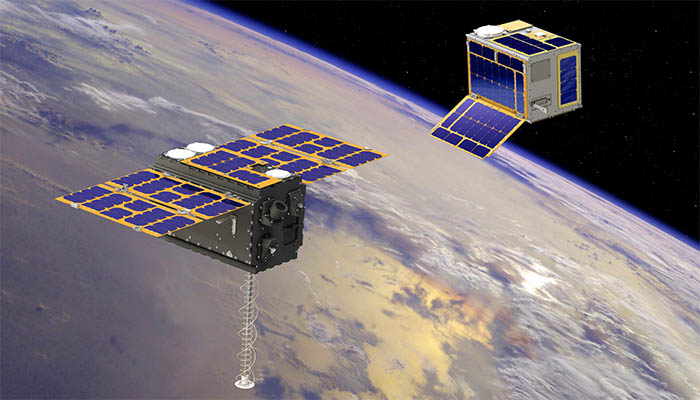ESA’s LEO-PNT satellites set to launch by end of year
The European Space Agency (ESA) confirms the launch of the first two LEO-PNT satellites is planned from second half of December 2025, on a Rocket Lab Electron launcher vehicle, from New Zealand. The LEO-PNT in-orbit demonstrator mission is a pioneer mission for Europe that will advance satellite navigation concepts for resilient positioning and timing services.
Approved at the ESA Council at Ministerial Level in 2022, ESA’s LEO-PNT (Low Earth Orbit Positioning Navigation and Timing) in-orbit demonstrator mission has been established to test the potential of a satellite navigation system in low Earth orbit and its contribution to a multi-layer navigation system.
A 10-satellite constellation is being developed under two parallel contracts with GMV (Spain) and Thales Alenia Space (France) as prime contractors. The first two satellites of this constellation (one Pathfinder A per contract) have now secured a ride to low Earth orbit before the end of this year.
The launch agreement between ESA, GMV, Thales Alenia Space and launch provider Rocket Lab was necessary to meet the scheduling requirements of the demonstrator mission. The dedicated launch with the Electron rocket will bring both satellites to their orbit at 510 km altitude. The satellites will be launched from the company’s site in New Zealand with a three month launch period starting mid-December.
ESA Director of Navigation, Javier Benedicto, said: “We are thrilled to see the LEO-PNT demonstration advancing so quickly, with less than two years between mission kick-off and launch. This launch ensures the first European LEO-PNT satellites are in space before spring 2026, crucial for bringing the frequencies into use in compliance with the International Telecommunications Union.”
Why LEO-PNT?
Global Navigation Satellite Systems (GNSS) such as the European Galileo are a huge success: they fuel our society, generate economic growth and are integral to our security. Our increasing reliance on navigation technology inspires new applications that require very high availability, reliability and accuracy in all environments.
As recognised internationally, a pivotal step for better navigation is expanding into a system including low Earth orbit satellites and operating in a range of signals in different frequencies.
LEO-PNT satellites are expected to provide significant augmentation and diversity to existing and future medium Earth orbit (MEO) based GNSS, increasing resilience and enabling new services to places where today’s satnav systems cannot reach, like deep urban areas, under heavy foliage, in polar regions and even indoor.
First two of ten satellites
Under the LEO-PNT in-orbit demonstrator mission, two prime industrial partners are developing a total of 12 satellites: two Pathfinder A satellites (one to fly and one spare) and four Pathfinder B satellites each.
The first to fly will be Pathfinder A, large CubeSats (12U and 16U) the size of a suitcase weighing around 20 kg and 30 kg with payloads to broadcast in L- and S- bands. They will validate the system definition and early signal broadcast, de-risk and demonstrate technology for the core elements for succeeding LEO-PNT satellites. They will operate after in-orbit commissioning for a at least six months.
The satellite integration and testing of hardware and software of Pathfinder A satellites is well under way before their ride to orbit in a little less than six months. The development of the ground segment and test user receivers is also ongoing. ESA and industrial teams will complete testing of the satellites during summer, with qualification and acceptance review in autumn.
“Pathfinder A satellites have already paid off, even before launch. The experience gathered during their development is helping to identify critical technologies, system design trade-offs, design choices and optimised approaches and processes, paving the way for future phases of LEO-PNT. Having them in orbit and validating their signals and algorithms is a major additional achievement,” said ESA’S LEO-PNT Project Manager Roberto Prieto-Cerdeira.
Pathfinder B satellites are larger and more complex and will build on the knowledge acquired during the design, development and integration of Pathfinder A satellites. They will carry additional payloads to test innovative signals across frequency bands and demonstrate the provision of additional services.
Once the whole demonstrator constellation is in orbit, in 2027, it will be able to assess how a navigation system on low Earth orbit can work in combination with Galileo and other satellite navigation systems in medium Earth orbit. The mission will also demonstrate interoperability with open communication standards, including 5G and 6G, opening the door to new applications in transportation, autonomous vehicles, critical infrastructure, mobile devices and much more.
After the in-orbit demonstrator mission, the in-orbit preparatory phase (to be proposed at ESA’s next Ministerial Council in November) will focus on technology development, industrialisation and in-orbit validation, bridging the gap with a potential operational system as part of the European Union GNSS infrastructure together with Galileo and EGNOS, also supporting potential commercial initiatives.
The LEO-PNT demonstrator mission is part of FutureNAV, an ESA Navigation programme that enables the agency to respond to trends and needs in this field, allowing Europe to stay on the cutting edge of satellite navigation technology.
About LEO-PNT
ESA’s LEO-PNT (Low Earth Orbit Positioning Navigation and Timing) in-orbit demonstrator mission features a constellation of 10 satellites plus two spares that will fly in low Earth orbit to test innovative signals across various frequency bands. Its goal is to advance satellite navigation concepts for resilient positioning and timing services.
The mission was approved at ESA’s Council at Ministerial Level of 2022 and is supported by Austria, Belgium, Finland, France, Germany, Hungary, Italy, Norway, Poland, Portugal, Romania, Spain, Sweden, Switzerland and the United Kingdom. Two parallel contracts to develop the fleet were awarded in 2024 to two consortia involving over 50 entities from 14 countries.
LEO-PNT in-orbit demonstrator includes end-to-end definition, development of space and test user segment, launch, ground segment and operations, experimentation, demonstration of services and satellite disposal. For more information, visit www.esa.int/LEO-PNT
Source : ESA









Be the first to comment on "ESA’s LEO-PNT"